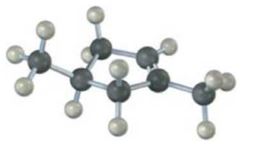
EBK ORGANIC CHEMISTRY
9th Edition
ISBN: 8220100591310
Author: McMurry
Publisher: CENGAGE L
expand_more
expand_more
format_list_bulleted
Concept explainers
Textbook Question
Chapter 8.5, Problem 11P
Tho following cycloalkene gives a mixture of two alcohols on hydroboration followed by oxidation. Draw the structures of both, and explain the result.

Expert Solution & Answer
Want to see the full answer?
Check out a sample textbook solution
Students have asked these similar questions
Hi can you please help me solve these problems? thank you
Hi can you please help me solve these problems? thank you
Hi can you please help me solve this problem? thank you
Chapter 8 Solutions
EBK ORGANIC CHEMISTRY
Ch. 8.1 - Prob. 1PCh. 8.1 - How many alkene products, including E,Z isomers,...Ch. 8.2 - Prob. 3PCh. 8.2 - Addition of HCl to 1, 2-dimethylcyclohexene yields...Ch. 8.3 - Prob. 5PCh. 8.3 - Prob. 6PCh. 8.4 - Prob. 7PCh. 8.4 - From what alkenes might the following alcohols...Ch. 8.5 - Prob. 9PCh. 8.5 - What alkenes might be used to prepare the...
Ch. 8.5 - Tho following cycloalkene gives a mixture of two...Ch. 8.6 - Prob. 12PCh. 8.7 - Prob. 13PCh. 8.7 - Starting with an alkene, how would you prepare...Ch. 8.8 - Prob. 15PCh. 8.8 - Prob. 16PCh. 8.9 - What products would you expect from the following...Ch. 8.10 - Prob. 18PCh. 8.10 - Prob. 19PCh. 8.13 - Prob. 20PCh. 8.13 - What products are formed from hydration of...Ch. 8.SE - Name the following alkenes, and predict the...Ch. 8.SE - Prob. 23VCCh. 8.SE - Prob. 24VCCh. 8.SE - Prob. 25VCCh. 8.SE - Prob. 26MPCh. 8.SE - Prob. 27MPCh. 8.SE - Draw the structures of the organoboranes formed...Ch. 8.SE - Prob. 29MPCh. 8.SE - Provide the mechanism and products for the...Ch. 8.SE - Propose a curved-arrow mechanism to show how ozone...Ch. 8.SE - Prob. 32MPCh. 8.SE - Prob. 33MPCh. 8.SE - Prob. 34MPCh. 8.SE - 10-Bromo- α -chamigrene, a compound isolated from...Ch. 8.SE - Isolated from marine algae, prelaureatin is...Ch. 8.SE - Dichlorocarbene can be generated by heating sodium...Ch. 8.SE - Reaction of cyclohexene with mercury(II) acetate...Ch. 8.SE - Use your general knowledge of alkene chemistry to...Ch. 8.SE - Prob. 40MPCh. 8.SE - Hydroboration of 2-methyl-2-pentene at 25°C,...Ch. 8.SE - Prob. 42APCh. 8.SE - Suggest structures for alkenes that give the...Ch. 8.SE - Prob. 44APCh. 8.SE - Prob. 45APCh. 8.SE - Prob. 46APCh. 8.SE - Prob. 47APCh. 8.SE - Predict the products of the following reactions....Ch. 8.SE - Prob. 49APCh. 8.SE - How would you carry out the following...Ch. 8.SE - Draw the structure of an alkene that yields only...Ch. 8.SE - Show the structures of alkenes that give the...Ch. 8.SE - Prob. 53APCh. 8.SE - Which of the following alcohols could not be made...Ch. 8.SE - Prob. 55APCh. 8.SE - Prob. 56APCh. 8.SE - Prob. 57APCh. 8.SE - Compound A has the formula C10HI6. On catalytic...Ch. 8.SE - Prob. 59APCh. 8.SE - Prob. 60APCh. 8.SE - Prob. 61APCh. 8.SE - Draw the structure of a hydrocarbon that absorbs 2...Ch. 8.SE - Prob. 63APCh. 8.SE - The sex attractant of the common housefly is a...Ch. 8.SE - Prob. 65APCh. 8.SE - Prob. 66APCh. 8.SE - α-Terpinene, C10H16, is a pleasant-smelling...Ch. 8.SE - Prob. 68APCh. 8.SE - Prob. 69APCh. 8.SE - Prob. 70APCh. 8.SE - Prob. 71APCh. 8.SE - Prob. 72AP
Knowledge Booster
Learn more about
Need a deep-dive on the concept behind this application? Look no further. Learn more about this topic, chemistry and related others by exploring similar questions and additional content below.Similar questions
- At a metal-solution interface, an electron is exchanged, and the symmetry factor beta < 0.5 is found in the Butler-Volmer equation. What does this indicate?arrow_forwardTopic: Photochemistry and Photophysics of Supramoleculesarrow_forwardTopic: Photochemistry and Photophysics of Supramoleculesarrow_forward
- How to name hydrocarbonsarrow_forwardPlease do these questions within the SCH4U course please with full steps since I am still unsure how to format my answers! Thank you so much.arrow_forwardWhen two solutions, one of 0.1 M KCl (I) and the other of 0.1 M MCl (II), are brought into contact by a membrane. The cation M cannot cross the membrane. At equilibrium, x moles of K+ will have passed from solution (I) to (II). To maintain the neutrality of the two solutions, x moles of Cl- will also have to pass from I to II. Explain this equality: (0.1 - x)/x = (0.1 + x)/(0.1 - x)arrow_forward
- Calculate the variation in the potential of the Pt/MnO4-, Mn2+ pair with pH, indicating the value of the standard potential. Data: E0 = 1.12.arrow_forwardGiven the cell: Pt l H2(g) l dis X:KCl (sat) l Hg2Cl2(s) l Hg l Pt. Calculate the emf of the cell as a function of pH.arrow_forwardThe decimolar calomel electrode has a potential of 0.3335 V at 25°C compared to the standard hydrogen electrode. If the standard reduction potential of Hg22+ is 0.7973 V and the solubility product of Hg2Cl2 is 1.2x 10-18, find the activity of the chlorine ion at this electrode.Data: R = 8.314 J K-1 mol-1, F = 96485 C mol-1, T = 298.15 K.arrow_forward
arrow_back_ios
SEE MORE QUESTIONS
arrow_forward_ios
Recommended textbooks for you

 Organic Chemistry: A Guided InquiryChemistryISBN:9780618974122Author:Andrei StraumanisPublisher:Cengage Learning
Organic Chemistry: A Guided InquiryChemistryISBN:9780618974122Author:Andrei StraumanisPublisher:Cengage Learning Organic ChemistryChemistryISBN:9781305580350Author:William H. Brown, Brent L. Iverson, Eric Anslyn, Christopher S. FootePublisher:Cengage Learning
Organic ChemistryChemistryISBN:9781305580350Author:William H. Brown, Brent L. Iverson, Eric Anslyn, Christopher S. FootePublisher:Cengage Learning


Organic Chemistry: A Guided Inquiry
Chemistry
ISBN:9780618974122
Author:Andrei Straumanis
Publisher:Cengage Learning

Organic Chemistry
Chemistry
ISBN:9781305580350
Author:William H. Brown, Brent L. Iverson, Eric Anslyn, Christopher S. Foote
Publisher:Cengage Learning
Alcohols, Ethers, and Epoxides: Crash Course Organic Chemistry #24; Author: Crash Course;https://www.youtube.com/watch?v=j04zMFwDeDU;License: Standard YouTube License, CC-BY